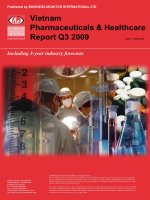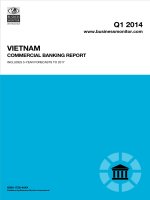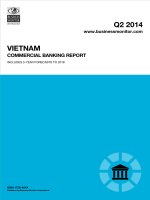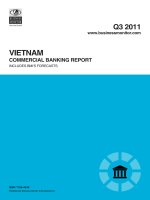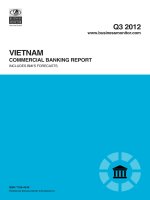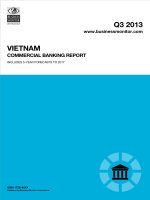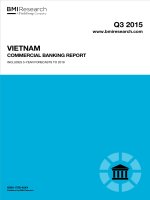Vietnam pharmaceuticals healthcare report q3 2014
Bạn đang xem bản rút gọn của tài liệu. Xem và tải ngay bản đầy đủ của tài liệu tại đây (759.83 KB, 132 trang )
Q3 2014
www.businessmonitor.com
VIETNAM
PHARMACEUTICALS & HEALTHCARE REPORT
INCLUDES 10-YEAR FORECASTS TO 2023
ISSN 1748-2305
Published by:Business Monitor International
Vietnam Pharmaceuticals &
Healthcare Report Q3 2014
INCLUDES 10-YEAR FORECASTS TO 2023
Part of BMI’s Industry Report & Forecasts Series
Published by: Business Monitor International
Copy deadline: June 2014
Business Monitor International
Senator House
85 Queen Victoria Street
London
EC4V 4AB
United Kingdom
Tel: +44 (0) 20 7248 0468
Fax: +44 (0) 20 7248 0467
Email:
Web:
© 2014 Business Monitor International
All rights reserved.
All information contained in this publication is
copyrighted in the name of Business Monitor
International, and as such no part of this
publication may be reproduced, repackaged,
redistributed, resold in whole or in any part, or used
in any form or by any means graphic, electronic or
mechanical, including photocopying, recording,
taping, or by information storage or retrieval, or by
any other means, without the express written consent
of the publisher.
DISCLAIMER
All information contained in this publication has been researched and compiled from sources believed to be accurate and reliable at the time of
publishing. However, in view of the natural scope for human and/or mechanical error, either at source or during production, Business Monitor
International accepts no liability whatsoever for any loss or damage resulting from errors, inaccuracies or omissions affecting any part of the
publication. All information is provided without warranty, and Business Monitor International makes no representation of warranty of any kind as
to the accuracy or completeness of any information hereto contained.
CONTENTS
BMI Industry View 7
SWOT 9
Political 11
Economic 12
Business Environment 13
Industry Forecast 14
Pharmaceutical Market Forecast 14
Table: Pharmaceutical Sales, Historical Data And Forecasts (Vietnam 2010-2018) 15
Healthcare Market Forecast 16
Table: Healthcare Expenditure Trends, Historical Data And Forecasts (Vietnam 2010-2018) 19
Table: Government Healthcare Expenditure Trends, Historical Data And Forecasts (Vietnam 2010-2018) 19
Table: Private Healthcare Expenditure Trends, Historical Data And Forecasts (Vietnam 2010-2018) 20
Prescription Drug Market Forecast 21
Table: Prescription Drug Market Indicators, Historical Data And Forecasts (Vietnam 2010-2018) 22
Patented Drug Market Forecast 23
Table: Patented Drug Market Indicators, Historical Data And Forecasts (Vietnam 2010-2018) 24
Generic Drug Market Forecast 25
Table: Generic Drug Market Indicators, Historical Data And Forecasts (Vietnam 2010-2018) 26
OTC Medicine Market Forecast 27
Table: Over-The-Counter (OTC) Medicine Market Indicators, Historical Data And Forecasts (Vietnam 2010-2018) 29
Pharmaceutical Trade Forecast 30
Table: Pharmaceutical Trade Data And Forecasts (Vietnam 2012-2018) 31
Table: Pharmaceutical Trade Data And Forecasts local currency (Vietnam 2012-2018) 32
Other Healthcare Data 32
Key Risks To BMI's Forecast Scenario 33
Macroeconomic Forecasts 34
Economic Analysis 34
Table: Foreign Direct Investment By Country Of Origin (Top Five) 38
Table: Vietnam - Economic Activity 39
Industry Risk Reward Ratings 40
Asia Risk/Reward Ratings 40
Vietnam Risk/Reward Ratings 46
Rewards 46
Risks 46
Market Overview 48
Industry Trends And Developments 50
Vietnam Pharmaceuticals & Healthcare Report Q3 2014
© Business Monitor International Page 4
Epidemiology 50
Healthcare Financing 52
Hospital Sector 54
Private Healthcare Sector 56
Healthcare Insurance 58
Healthcare And Pharmaceutical Reform 60
Research And Development 62
Biotechnology Sector 63
Clinical Trials 67
Regulatory Development 69
Regulatory Regime 69
Pharmaceutical Advertising 70
Intellectual Property Environment 71
Corruption 75
Pricing Regime 75
Reimbursement Regime 80
Pricing And Reimbursement Developments 81
Competitive Landscape 84
Pharmaceutical Sector 84
Domestic Industry 85
Foreign Industry 88
Traditional Medicines 90
Pharmaceutical Distribution 91
Pharmaceutical Retail Sector 92
Table: Key Aspects Of Good Pharmacy Practice In Developing Countries 93
Company Profile 94
DHG Pharmaceutical 94
Traphaco Pharmaceutical 96
Vietnam Pharmaceutical Corporation (Vinapharm) 98
Vietnam OPV Pharmaceutical Co 101
Vietnam Pharmaceutical Joint Stock Company (Ampharco) 103
Vidipha Central Pharmaceutical Joint Stock Company 106
Pfizer 108
Sanofi 110
Novartis 114
Merck & Co 116
GlaxoSmithKline 118
Demographic Forecast 120
Table: Vietnam's Population By Age Group, 1990-2020 ('000) 121
Table: Vietnam's Population By Age Group, 1990-2020 (% of total) 122
Table: Vietnam's Key Population Ratios, 1990-2020 123
Vietnam Pharmaceuticals & Healthcare Report Q3 2014
© Business Monitor International Page 5
Table: Vietnam's Rural And Urban Population, 1990-2020 123
Glossary 124
Methodology 126
Pharmaceutical Expenditure Forecast Model 126
Healthcare Expenditure Forecast Model 126
Notes On Methodology 127
Risk/Reward Ratings Methodology 128
Ratings Overview 129
Table: Pharmaceutical Risk/Reward Ratings Indicators 129
Indicator Weightings 130
Vietnam Pharmaceuticals & Healthcare Report Q3 2014
© Business Monitor International Page 6
BMI Industry View
BMI View: Extensive bureaucracy and a lack of human resources in regulatory agencies are the two key
reasons for the market barriers that innovative pharmaceutical firms face in accessing Vietnam's
pharmaceutical market. Despite these obstacles, we maintain that overreliance on imported
pharmaceuticals will ensure pharmaceutical firms' presence in the market over our forecast period.
Headline Expenditure Projections
■
Pharmaceuticals: VND69,297bn (USD3.30bn) in 2013 to VND80,680bn (USD3.92bn) in 2014; +16.4%
in local currency terms and +19.1% in US dollar terms. Forecast unchanged from previous quarter.
■
Healthcare: VND222,374bn (USD10.57bn) in 2013 to VND254,491bn (USD12.37bn) in 2014; +14.4%
in local currency terms and +17.0% in US dollar terms. Forecast reassessed due to receipt of new data
from the World Health Organization.
Risk/Reward Rating:
Vietnam's Pharmaceutical Risk/Reward Rating (RRR) score for Q313 is 49.1 out of the maximum 100 in
our newly improved RRR system. The country scored above average for some indicators and sub-
indicators, including overall market expenditure, sector value growth and pensionable population.
Consequently, with this moderate score, Vietnam is ranked 12
th
behind Thailand out of the 19 key markets
in Asia Pacific.
Key Trends And Developments
■
In June 2014, CEO Tan See Leng stated that Malaysian hospital operator IHH Healthcare is focusing on
expanding further in emerging markets like China, Vietnam and Myanmar. The company will particularly
focus on China as Beijing is moving to ease curbs on foreign investment in joint venture hospitals in
order to improve its healthcare system, according to Leng. The company will explore both organic and
inorganic growth opportunities in Myanmar and Vietnam,
■
In May 2014, the Vietnamese health ministry reported a shortage of vaccines, due to companies reducing
the amount of vaccines imported in 2014. The companies could not sell the vaccines they had imported in
2013. The nation has two immunisation programmes: the national immunisation programme and
immunisation services. The ministry supplies 11 free vaccines, including vaccines that prevent
tuberculosis, diphtheria, polio and whooping cough, under the national immunisation programme.
■
In April 2014, the Drug Administration of Vietnam found that pharmaceuticals manufactured by several
Indian companies are Not of Standard Quality (NSQ), and has banned these firms from supplying
products to Vietnam. According to news source DNA India at least 45 Indian pharmaceutical firm such as
Medley Pharmaceuticals, Marck Biosciences, UMedica Laboratories and Marksans Pharma are
now unable to supply their products to the South East Asian country. In addition to the Indian
companies, nine pharmaceutical companies from South Korea, two from Bangladesh, two from France,
Vietnam Pharmaceuticals & Healthcare Report Q3 2014
© Business Monitor International Page 7
and one from the US, Philippines, Pakistan, Indonesia, Germany, Cyprus and Canada were also banned
from supplying drugs to Vietnam.
BMI Economic View: Vietnam's external sector will remain stable over the coming years, as a combination
of strong macroeconomic dynamics, the ongoing de-dollarization of the economy and subdued inflationary
pressures result in broad exchange rate stability. Moreover, we highlight that strengthening trade dynamics,
combined with rising foreign direct investment - on the back of significant improvements in the business
environment - will continue to bolster the country's external accounts.
BMI Political View: Vietnam's political outlook is stable, and we see room for substantial reform over the
coming years, particularly with regard to the business environment. Moreover, Vietnam is increasingly
opening up to the international community, which will be good for longer-term development. That said,
Vietnam has a poor record in terms of human rights protection, and there continues to be a lack of freedom
for the press and media.
Vietnam Pharmaceuticals & Healthcare Report Q3 2014
© Business Monitor International Page 8
SWOT
SWOT Analysis
Strengths
■
Significant growth potential, given a large and growing population.
■
The government's commitment to developing the health sector.
■
Sizeable local generic drugs sector, which is being encouraged by the government.
■
Strong traditional medicines segment with potential to improve the non-prescription
drugs market in the longer term, as long as sufficient investment in extraction
technologies can be found.
Weaknesses
■
One of the least developed pharmaceutical markets in Asia, with low per capita
spending on drugs.
■
Counterfeit drugs account for a significant amount of market consumption.
■
No bioequivalence requirement in place for locally made generic medicines.
■
Little distinction made between prescription and over-the-counter drugs, with most
medicines available without a prescription.
■
Complex drug pricing policy biased towards local drug producers.
■
Import-reliant market, especially in terms of high-tech products and active
pharmaceutical ingredients, which makes it vulnerable to currency movements.
■
Underdeveloped primary care services and a shortage of trained pharmacists are
continuing to hamper access to medicines and product market penetration.
■
Population concentrated in rural, rather than urban, areas, preventing access to
modern drugs and encouraging dependence upon traditional medicines.
Opportunities
■
The Association of South East Asian Nations (ASEAN) harmonisation initiative,
including the adoption of Western regulatory standards such as International
Conference on Harmonisation and World Health Organization guidelines.
Vietnam Pharmaceuticals & Healthcare Report Q3 2014
© Business Monitor International Page 9
SWOT Analysis - Continued
■
Introduction of five-year exclusivity for clinical dossier data encouraging research-
based multinationals.
■
If investment can be found for technological improvements, then there is great
potential in the traditional Chinese medicine market, in addition to fledging
biotechnology.
■
Full WTO membership improving the trading climate and potentially, in the longer
term, redressing pharmaceutical trade issues.
■
Requirement for domestic companies to comply with international good
manufacturing practices should boost exports.
Threats
■
Government resistance to aligning patent law fully with international standards
deterring multinational sector expansion.
■
Need to resolve infrastructural and power supply issues, as well as higher education
provision, before higher levels of foreign direct investment can be expected.
■
The government is increasingly interfering in the industry, protecting indigenous firms
through the use of legal trade barriers, which will affect competitiveness.
■
Pharmaceutical price inflation threatens to put medicines out of reach of poor and
therefore limit market volume growth.
■
Legalisation of parallel imports negatively impacting performance of patented drugs.
Vietnam Pharmaceuticals & Healthcare Report Q3 2014
© Business Monitor International Page 10
Political
SWOT Analysis
Strengths
■
The Communist Party of Vietnam remains committed to market-oriented reforms and
we do not expect major shifts in policy direction over the next five years. The one-
party system is generally conducive to short-term political stability.
■
Relations with the US have witnessed a marked improvement, and Washington sees
Hanoi as a potential geopolitical ally in South East Asia.
Weaknesses
■
Corruption among government officials poses a major threat to the legitimacy of the
ruling Communist Party.
■
There is increasing (albeit still limited) public dissatisfaction with the leadership's tight
control over political dissent.
Opportunities
■
The government recognises the threat corruption poses to its legitimacy, and has
acted to clamp down on graft among party officials.
■
Vietnam has allowed legislators to become more vocal in criticising government
policies. This is opening up opportunities for more checks and balances within the
one-party system.
Threats
■
Macroeconomic instabilities continue to weigh on public acceptance of the one-party
system, and street demonstrations to protest economic conditions could develop into
a full-on challenge of undemocractic rule.
■
Although strong domestic control will ensure little change to Vietnam's political scene
in the next few years, over the longer term, the one-party-state will probably be
unsustainable.
■
Relations with China have deteriorated over recent years due to Beijing's more
assertive stance over disputed islands in the South China Sea and domestic criticism
of a large Chinese investment into a bauxite mining project in the central highlands,
which could potentially cause wide-scale environmental damage.
Vietnam Pharmaceuticals & Healthcare Report Q3 2014
© Business Monitor International Page 11
Economic
SWOT Analysis
Strengths
■
Vietnam has been one of the fastest-growing economies in Asia in recent years, with
GDP growth averaging 7.1% annually between 2000 and 2012.
■
The economic boom has lifted many Vietnamese out of poverty, with the official
poverty rate in the country falling from 58% in 1993 to 20.7% in 2012.
Weaknesses
■
Vietnam still suffers from substantial trade and fiscal deficits, leaving the economy
vulnerable to global economic uncertainties. The fiscal deficit is dominated by
substantial spending on social subsidies that could be difficult to withdraw.
■
The heavily-managed and weak currency reduces incentives to improve quality of
exports, and also keeps import costs high, contributing to inflationary pressures.
Opportunities
■
WTO membership and the upcoming ASEAN AEC in 2015 should give Vietnam
greater access to both foreign markets and capital, while making Vietnamese
enterprises stronger through increased competition.
■
The government will in spite of the current macroeconomic woes, continue to move
forward with market reforms, including privatisation of state-owned enterprises, and
liberalising the banking sector.
■
Urbanisation will continue to be a long-term growth driver. The UN forecasts the
urban population rising from 29% of the population to more than 50% by the early
2040s.
Threats
■
Inflation and deficit concerns have caused some investors to re-assess their hitherto
upbeat view of Vietnam. If the government focuses too much on stimulating growth
and fails to root out inflationary pressure, it risks prolonging macroeconomic
instability, which could lead to a potential crisis.
■
Prolonged macroeconomic instability could prompt the authorities to put reforms on
hold as they struggle to stabilise the economy.
Vietnam Pharmaceuticals & Healthcare Report Q3 2014
© Business Monitor International Page 12
Business Environment
SWOT Analysis
Strengths
■
Vietnam has a large, skilled and low-cost workforce, which has made the country
attractive to foreign investors.
■
Vietnam's location - its proximity to China and South East Asia, and its good sea links
- makes it a good base for foreign companies to export to the rest of Asia, and
beyond.
Weaknesses
■
Vietnam's infrastructure is still weak. Roads, railways and ports are inadequate to
cope with the country's economic growth and links with the outside world.
■
Vietnam remains one of the world's most corrupt countries. According to
Transparency International's 2012 Corruption Perceptions Index, Vietnam ranks 123
out of 176 countries.
Opportunities
■
Vietnam is increasingly attracting investment from key Asian economies, such as
Japan, South Korea and Taiwan. This offers the possibility of the transfer of high-tech
skills and know-how.
■
Vietnam is pressing ahead with the privatisation of state-owned enterprises and the
liberalisation of the banking sector. This should offer foreign investors new entry
points.
Threats
■
Ongoing trade disputes with the US, and the general threat of American
protectionism, which will remain a concern.
■
Labour unrest remains a lingering threat. A failure by the authorities to boost skills
levels could leave Vietnam a second-rate economy for an indefinite period.
Vietnam Pharmaceuticals & Healthcare Report Q3 2014
© Business Monitor International Page 13
Industry Forecast
Pharmaceutical Market Forecast
Vietnam's pharmaceutical market was valued at
VND69,297bn (USD3.30bn) in 2013, a 17.0% year-
on-year increase in local currency terms. Over the
forecast period to 2018, BMI expects
pharmaceutical consumption to reach
VND139,832bn (USD7.06bn), equating to a
compound annual growth rate (CAGR) of 15.1% in
local currency and 16.5% in US dollar terms. Over
the extended forecast period to 2023, the CAGRs
will be slightly lower, but will remain in double-digit
figures.
Inflation will be a major factor in these high nominal
market growth rates. However, we highlight that
there is considerable scope for increased
pharmaceutical consumption in a country where per
capita drug expenditure is just USD35.94. This,
combined with an expanding population, higher
levels of health awareness and increased access to
pharmaceuticals, creates a strong base for market growth assuming the required resources are put into
healthcare sector development. However, pricing remains a concern, due to a lack of controls and regulatory
bias against foreign products.
Additionally, some have blamed unscrupulous practices by pharmaceutical companies and prescribers for
pharmaceutical expenditure being higher than necessary. However, it is not just companies that bribe
Vietnamese healthcare professionals. Patients pay doctors and nurses to avoid waiting lists and receive
above-average care. Those on low incomes that cannot afford 'gifts' for staff members have to use
overcrowded facilities and rely on relatives to complement the provision of care.
In fact, according to a survey by the Vietnam Union of Science and Technology Associations (VUSTA)
published on the VietNamNet Bridge website in September 2009, gifts - which we interpret mostly as cash,
but can also be physical goods - accounted for 9% of the cost of a health check-up. The research was
Pharmaceutical Market Forecast
2009-2023
Pharmaceutical sales, USDbn (LHS)
Pharmaceutical sales constant exchange rate, USDbn (LHS)
Pharmaceutical sales, % of GDP (RHS)
2009
2010
2011
2012
2013
2014f
2015f
2016f
2017f
2018f
2019f
2020f
2021f
2022f
2023f
0
5
10
15
0
1
2
3
f = BMI forecast. Source: BMI, Drug Administration of
Vietnam (DAV), Vietnam Ministry of Health, domestic
companies, local press.
Vietnam Pharmaceuticals & Healthcare Report Q3 2014
© Business Monitor International Page 14
performed through interviews with 140 people in rural and urban areas who had visited public and private
hospitals over the previous six months. Interestingly, 'medications/examinations/tests' only accounted for
53% of expenditure. It is not clear how the remaining funds were spent.
Vietnam's regulators faced their greatest challenge with the country's entrance to the WTO at the start of
2007. Foreign enterprises have been given the right to open branches in Vietnam and to import medicines
directly, although they will still be barred from distributing their products. As part of its membership
application, Vietnam pledged to set import duties at less than 5% for pharmaceutical products and drug
tariffs are expected to average just 2.5% within five years of accession.
The liberalised environment could cause problems for Vietnam's small drug production sector.
Nevertheless, while the government originally called on firms to adopt GMP standards by the start of 2010,
the deadline was extended to the end of 2010. However, in August 2008, it was revealed that companies that
did not have accreditation could come up with provisory regulations. Firms not planning to establish GMP
standards must either shift to other sectors or produce traditional medicines, the latter being an area with
problems of its own, as many traditional drugs are incorrectly labelled and dispensed by unqualified
practitioners. According to Savipharm, the country has 108 factories compliant to GMP-WHO, few plants
compliant to EU and Japanese GMP as of November 2011. Meanwhile in January 2012, United
International Pharma Company became the first company with a facility that is compliant with the
Pharmaceutical Inspection Convention and Pharmaceutical Inspection Co-operation Scheme (PIC/S) GMP
standards.
Table: Pharmaceutical Sales, Historical Data And Forecasts (Vietnam 2010-2018)
2010 2011 2012 2013 2014f 2015f 2016f 2017f 2018f
Pharmaceutical sales, USDbn 2.056 2.425 2.837 3.295 3.923 4.602 5.341 6.167 7.062
Pharmaceutical sales, USDbn, % y-o-
y
20.17 17.91 17.01 16.16 19.05 17.29 16.06 15.48 14.52
Pharmaceutical sales, VNDbn 39,316 50,082 59,214 69,297 80,680 93,549 107,960 123,342 139,832
Pharmaceutical sales, VNDbn, % y-o-
y
29.09 27.38 18.23 17.03 16.43 15.95 15.40 14.25 13.37
Pharmaceutical sales constant
exchange rate, USDbn
1.870 2.382 2.816 3.295 3.837 4.449 5.134 5.865 6.650
Pharmaceutical sales, USD per capita 23.1 27.0 31.2 35.9 42.4 49.3 56.7 64.9 73.8
Pharmaceutical sales, % of GDP 1.82 1.80 1.82 1.93 2.01 2.08 2.14 2.20 2.23
Vietnam Pharmaceuticals & Healthcare Report Q3 2014
© Business Monitor International Page 15
Pharmaceutical Sales, Historical Data And Forecasts (Vietnam 2010-2018) - Continued
2010 2011 2012 2013 2014f 2015f 2016f 2017f 2018f
Pharmaceutical sales, % of health
expenditure
28.6 29.0 30.5 31.2 31.7 32.2 32.6 32.8 32.8
f = BMI forecast. Source: BMI, Drug Administration of Vietnam (DAV), Vietnam Ministry of Health, domestic companies,
local press.
Healthcare Market Forecast
In December 2013, we upgraded our forecast for
private health expenditure due to the government's
plan to raise hospitals fees between 2014 and 2018.
This quarter, we have slightly upgraded the
healthcare expenditure forecast due to the receipt of
actual 2012 data from the World Health
Organization (WHO). We now forecast that the
sector will reach a value of VND769,394bn
(USD40.18bn) by 2023. Through to 2018 and 2023,
the sector is projected to grow at local CAGRs of
13.9% and 13.2% respectively (15.3% and 14.3% in
US dollar terms).
Over the long term, Vietnam's healthcare sector is
forecast to grow in accordance with its strong
economic growth. However, we highlight that rising
healthcare expenditure does not necessarily equate to
quality healthcare provision. According to the General Statistics Office of Vietnam, the number of hospitals
in 2012 was 963. Meanwhile, the number of hospital beds and doctors per 1,000 people stayed flat - at 2.01
and 0.65 respectively.
Moreover, despite a double-digit growth in healthcare expenditure, the country has yet to address the rising
burden of communicable diseases such as tuberculosis, AIDS and hand, foot and mouth disease. Much of
this increased expenditure will be on health infrastructure, which remains basic in many rural areas. Over
the longer term, this is likely to result in greater access to basic medicines.
Healthcare Expenditure Forecast
2009-2023
Health spending, USDbn (LHS)
Health expenditure constant FX rate, USDbn (LHS)
Health spending, % of GDP (RHS)
2009
2010
2011
2012
2013
2014f
2015f
2016f
2017f
2018f
2019f
2020f
2021f
2022f
2023f
0
20
40
60
0
2
4
6
8
f = BMI forecast. Source: BMI, WHO.
Vietnam Pharmaceuticals & Healthcare Report Q3 2014
© Business Monitor International Page 16
The country's low per capita health and pharmaceutical expenditure highlights the population's poor access
to healthcare services and low affordability levels for medicines - particularly high-value drugs. This
represents a short-term challenge for pharmaceutical firms, but over the long term we believe economic
development will aid growth in the pharmaceutical and healthcare sector. Our country risk team remains
bullish about the Vietnamese economy as it forecasts strong economic growth through to 2023.
In the meantime, the government has outlined plans for the investment of up to USD1.5bn in the
pharmaceutical manufacturing sector over the next 10 years to reduce reliance on imports. The money is to
be used for a variety of programmes, including upgrading technology to meet GMP standards, the
development and expansion of the pharmaceutical supply network to poor and remote areas, the
establishment of joint ventures (JVs) with foreign players and achieving a greater percentage of domestic
pharmaceutical demand.
The government's intention to invest in the development of its biotechnology sector is likely to act as a
catalyst for wider industry reform, in particular concerning patent protection. However, local drug
production is still weak and incapable of meeting domestic demand, although local regulation reform on a
considerable scale is expected to attract foreign investment. In some sectors, such as vaccines, considerable
progress has been made to increase Vietnam's self-sufficiency, with the country now producing sufficient
measles vaccines domestically to meet national demand.
To help make further progress, the government has outlined plans to invest USD241mn in eight projects
within the local drug manufacturing industry. This will include the construction of four pharmaceutical
plants in the next four years. The authorities aim to have 80% of domestic demand met by local producers
by 2020, up from around 50% currently.
In a workshop help by Vietnam Ministry of Health in August 2013 in collaboration between Medical
Excellence Japan and Japan's Ministry of Economy, Trade and Industry, the two countries reiterated Japan's
support towards Vietnamese healthcare through investment in three hospitals including: Bach Mai Hospital,
Hue Central Hospital and Cho Ray Hospital.
In an interview with local media, Vietnam News, Pham Le Tuan, deputy minister of health, stated that
public hospital fees will increase progressively until 2018, in line with Decree 85/2012/ND-CP. In 2012, the
government increased the prices of three out of seven cost elements incurred by patients, which include the
cost of medicines, chemicals, consumable materials, electricity, water, equipment maintenance and others.
Under the plan developed by the Ministry of Health on increasing hospital fees, this will cover the
Vietnam Pharmaceuticals & Healthcare Report Q3 2014
© Business Monitor International Page 17
remaining four out of seven cost elements (beds, medical equipment, salaries, and other hospital operation
costs). These four elements were previously covered by the government.
Timeline Of Hospital Fees Increments
■
2014: Hospital fees charged to patients will include the bed cost for inpatient services and part of the cost
of their surgery.
■
2015: Fees will include medical equipment used for patient treatment, hospitals' management and
operating costs and 20-30% of hospital staff's basic salary at provincial hospitals in mountainous regions,
central highlands and district hospitals in Ha Noi and Ho Chi Minh City.
■
2016-17: Part of the hospital fee will be used to pay basic salary cost for staff at provincial hospitals,
central government hospitals and district hospitals in two major cities of Ha Noi and Ho Chi Minh City.
■
Post-2018: full cost recovery policy for medical services will be implemented across the board.
The deputy health minister believes that with these increments in fees service quality will improve
considerably, as hospitals will be dependent on patients. He added that 'more patients mean more money for
hospital and their staff.' We highlight that this is potentially regressive as patients will have to shoulder the
burden of healthcare costs due to low funding from the government. In addition, we see a risk of
overcharging by hospitals if the implementation of these increments is not properly regulated. Conversely,
hospitals may also not generate sufficient revenues despite the implementation of the regulation. In August
2013, Vietnam News reported that hospitals in Ha Noi ran into problems in applying new hospital fees due
to unclear regulations and staffing shortages.
Nevertheless, as a result of these progressive increments, we have upgraded Vietnam's private healthcare
expenditure forecast, as the increased costs will be borne by patients rather than the government. Through to
2018, we forecast that private health expenditure will increase at a compound annual growth rate of 14.4%
(15.8% in US dollar terms). This growth rate is higher than government health expenditure (13.2%). We
highlight that the government may spend savings generated elsewhere to boost health services, such as
improving health infrastructure.
Vietnam Pharmaceuticals & Healthcare Report Q3 2014
© Business Monitor International Page 18
Table: Healthcare Expenditure Trends, Historical Data And Forecasts (Vietnam 2010-2018)
2010 2011 2012 2013 2014f 2015f 2016f 2017f 2018f
Health spending, USDbn 7.178 8.346 9.286 10.575 12.375 14.294 16.372 18.802 21.517
Health spending, USDbn, %
y-o-y
18.21 16.27 11.27 13.87 17.03 15.51 14.53 14.85 14.44
Health spending, VNDbn 137,256 172,398 193,834 222,374 254,491 290,606 330,955 376,049 426,029
Health spending, VNDbn, %
y-o-y
26.98 25.60 12.43 14.72 14.44 14.19 13.88 13.63 13.29
Health expenditure constant
FX rate, USDbn
6.527 8.198 9.218 10.575 12.102 13.819 15.738 17.882 20.259
Health spending, USD per
capita
80.6 92.8 102.3 115.3 133.7 153.1 173.8 198.0 224.8
Health spending, % of GDP 6.36 6.20 5.97 6.20 6.34 6.47 6.58 6.70 6.80
f = BMI forecast. Source: BMI, WHO.
Table: Government Healthcare Expenditure Trends, Historical Data And Forecasts (Vietnam 2010-2018)
2010 2011 2012 2013 2014f 2015f 2016f 2017f 2018f
Govt. health spend, USDbn 3.342 3.775 3.953 4.486 5.229 6.011 6.840 7.801 8.853
Govt. health spend, USDbn, % y-
o-y
31.29 12.97 4.71 13.51 16.55 14.95 13.80 14.06 13.49
Govt. health spend, VNDbn 63,893 77,976 82,502 94,345 107,534 122,195 138,267 156,026 175,296
Govt. health spend, VNDbn, % y-
o-y
41.04 22.04 5.80 14.36 13.98 13.63 13.15 12.84 12.35
Govt. health spend, % total health
spend
46.55 45.23 42.56 42.43 42.25 42.05 41.78 41.49 41.15
f = BMI forecast. Source: BMI, WHO.
Vietnam Pharmaceuticals & Healthcare Report Q3 2014
© Business Monitor International Page 19
Table: Private Healthcare Expenditure Trends, Historical Data And Forecasts (Vietnam 2010-2018)
2010 2011 2012 2013 2014f 2015f 2016f 2017f 2018f
Private health spend, USDbn 3.837 4.571 5.334 6.088 7.146 8.284 9.532 11.001 12.663
Private health spend, USDbn, %
y-o-y
8.77 19.14 16.69 14.14 17.37 15.92 15.07 15.41 15.11
Private health spend, VNDbn 73,364 94,422 111,333 128,029 146,957 168,411 192,688 220,023 250,733
Private health spend, VNDbn, %
y-o-y
16.84 28.70 17.91 15.00 14.78 14.60 14.42 14.19 13.96
Private health spend, % total
health expenditure
53.45 54.77 57.44 57.57 57.75 57.95 58.22 58.51 58.85
f = BMI forecast. Source: BMI, WHO.
Vietnam Pharmaceuticals & Healthcare Report Q3 2014
© Business Monitor International Page 20
Prescription Drug Market Forecast
The market figures for prescription and non-
prescription sectors are blurred by a lack of any
proper distinction between the two. In fact,
according to some drugstores, only 20-30% of
patients buy drugs with a prescription. Only
medicines that cause dependency, such as
benzodiazepines, are routinely refused sale without a
prescription. Antibiotics are the most popular drug
sold without a prescription. This has resulted in
worrying levels of antibiotic resistance. For
example, nearly 70% of bacteria carried by people
living in urban parts of Vietnam are resistant to
penicillin.
Nevertheless, the growth of the prescription
medicines market will outpace the growth of OTCs,
mainly due to the influx of expensive patented
products from abroad and increased demand for
sophisticated drugs. Additionally, tighter regulations
in the pharmaceuticals sector as a whole are likely to lead to the introduction of stricter dispensing
guidelines with the good pharmacy practice (GPP) recommendations coming into force in 2011.
By 2018, we forecast that prescription medicines will be worth VND104,612bn (USD5.28bn) at consumer
prices, posting a CAGR of 15.5% in local currency terms (thus somewhat above the wider pharmaceutical
market). In percentage terms, at this point, prescription drugs will account for 74.8% of the total market,
from 73.6% in 2013, driven by expanded access to formal healthcare in rural areas.
Demographic and environmental trends will be some of the key drivers of the prescription market in
Vietnam. Respiratory problems, including asthma and COPD, are on the rise, partly due to the high
prevalence of smoking and partly due to poor air quality. Manufacturers of drugs in the respiratory
therapeutic category will, therefore, have considerable room for expansion over the coming years. Similarly,
increased incidence of cancer, diabetes and hypertension among the Vietnamese population will provide
scope for drugmakers to expand.
Prescription Drug Market Forecast
2009-2023
Prescription drug sales, USDbn (LHS)
Prescription drug sales, % of total sales (RHS)
2009
2010
2011
2012
2013
2014f
2015f
2016f
2017f
2018f
2019f
2020f
2021f
2022f
2023f
0
2.5
5
7.5
10
0
20
40
60
80
f = BMI forecast. Source: BMI, Drug Administration of
Vietnam (DAV), Vietnam Ministry of Health, domestic
companies, local press.
Vietnam Pharmaceuticals & Healthcare Report Q3 2014
© Business Monitor International Page 21
One therapeutic area that has strong potential is oncology. At an international scientific conference in April
2013, Mai Trong Khoa, deputy director of Hanoi-based Bach Mai Hospital, stated that Vietnam reports
about 110,000 new cases of cancer annually, with over 73% of patients dying from the disease - one of the
highest rates in the world. He added that the average death rate in developing countries is 67.8% while that
for developed countries is 49.4%. In January 2014 a representative from the Vietnam Social Insurance
Agency stated that cancer drugs account for a large percentage of insurance expenses. Moreover,
prescribing patterns seem to be influenced by economic considerations, with drug companies paying
commissions to doctors who promote certain types of product. The HCMC authorities conducted an
investigation into the practice, with findings revealing that a number of doctors were in receipt of more than
VND500mn (USD26,300) each month. The investigators looked into the prescribing of Merck & Co's
hepatitis drugs - namely PegIntron (interferon Alfa-2b) in 50mcg and 80mcg dosages, with commissions
reportedly being in the region of 10% to 30% of the drugs' cost. Joint monthly revenues for the two drugs
are reportedly in excess of VND6bn (USD315,000). In September 2012, Nguyen Thi Kim Tien echoed
similar view stating that prescribers receive 'commission' from foreign pharmaceutical firms therefore many
prescriptions contain expensive medicines.
Local industry representatives claim that large firms can therefore gain an upper hand as they can afford to
pay higher commissions, although doctors' relationship with companies also have a role to play in their
decisions. Moreover, despite the existence of hospital medicine councils - which are in charge of making
prescribing suggestions and supervising prescribing patterns - many doctors can still suggest different types
of medicines to their patients. Patients have also stated that commissions are widespread.
Table: Prescription Drug Market Indicators, Historical Data And Forecasts (Vietnam 2010-2018)
2010 2011 2012 2013 2014f 2015f 2016f 2017f 2018f
Prescription drug sales, USDbn 1.497 1.772 2.080 2.424 2.896 3.408 3.969 4.598 5.283
Prescription drug sales, USDbn, % y-o-y 20.50 18.38 17.39 16.55 19.45 17.68 16.45 15.87 14.90
Prescription drug sales, VNDbn 28,622 36,603 43,420 50,982 59,553 69,283 80,224 91,964 104,612
Prescription drug sales, VNDbn, % y-o-y 29.45 27.88 18.62 17.42 16.81 16.34 15.79 14.63 13.75
Prescription drug sales, % of total sales 72.8 73.1 73.3 73.6 73.8 74.1 74.3 74.6 74.8
f = BMI forecast. Source: BMI, Drug Administration of Vietnam (DAV), Vietnam Ministry of Health, domestic companies,
local press.
Vietnam Pharmaceuticals & Healthcare Report Q3 2014
© Business Monitor International Page 22
Patented Drug Market Forecast
Value development of the patented drugs segment -
and consequently the overall prescription segment -
will be hampered by the government's plan to
contain pharmaceutical costs through restrictions on
advertising and the request that hospitals and
medical professionals give preference to
domestically produced drugs, as well as the fact that
most of the insured now incur some sort of co-
payment. Moreover, a number of high-value drugs
are due to come off patent in the coming years.
Nevertheless, the price increase evident since the
start of 2011 may take the value of the prescription
and patented markets beyond current estimates. By
2023, we expect the patented drug sector to reach
VND42,723bn (USD2.2bn), but represent a lower
percentage (18.04% versus 22.3% in 2013) of the
total market. Over the 2013-2023 period, patented
drugs are expected to post a CAGR of 10.7% in local
currency (11.7% in US dollar terms) - slightly below the rate of the overall market development.
Counterfeit drugs will continue to have a detrimental impact on patented drug sales over the forecast period,
despite the government's efforts to the contrary. The global economic slowdown has fuelled demand for
cheaper drugs, and counterfeit medicines are prospering as a result. Supported by the WHO, police, customs
and regulatory officials in the country have begun to coordinate their activities, although little can be done
in terms of enforcement without greater commitment to IP rights as well as more stringent penalties for
violators.
Corruption also has a role to play in drug prices, with commissions paid to pharmacists and doctors by sales
representatives and distributors to persuade them to prescribe their product to push up the retail price of
medicines. Such practices can only damage the industry as a whole, putting many patented products beyond
the budgets of the majority of the Vietnamese population.
Patented Drug Market Forecast
2009-2023
Patented drug sales, USDbn (LHS)
Patented drug sales, % of total sales (RHS)
2009
2010
2011
2012
2013
2014f
2015f
2016f
2017f
2018f
2019f
2020f
2021f
2022f
2023f
0
1
2
3
0
25
50
75
100
f = BMI forecast. Source: BMI, Drug Administration of
Vietnam (DAV), Vietnam Ministry of Health, domestic
companies, local press.
Vietnam Pharmaceuticals & Healthcare Report Q3 2014
© Business Monitor International Page 23
Speciality medicines, such as central nervous system (CNS) and cardiovascular drugs, are expected to be
the key growth area, while an increase in cancer, diabetes and hypertension will also generate product
demand. However, the basic nature of consumption is illustrated by the continued strong showing of
antibiotics and alimentary/metabolism products. The need to contain the HIV/AIDS epidemic and related
health problems will boost the antiretroviral sector, while the prevention of swine flu and similar diseases
continues to drive the growth of anti-flu drugs.
Table: Patented Drug Market Indicators, Historical Data And Forecasts (Vietnam 2010-2018)
2010 2011 2012 2013 2014f 2015f 2016f 2017f 2018f
Patented drug sales, USDbn 0.482 0.560 0.644 0.736 0.861 0.991 1.129 1.278 1.434
Patented drug sales, USDbn, % y-o-
y
18.28 16.19 15.04 14.30 16.98 15.17 13.88 13.21 12.17
Patented drug sales, VNDbn 9,210 11,560 13,438 15,474 17,702 20,154 22,821 25,561 28,386
Patented drug sales, VNDbn, % y-o-
y
27.06 25.52 16.24 15.15 14.40 13.85 13.23 12.01 11.05
Patented drug sales, % of
prescription sales
32.2 31.6 30.9 30.4 29.7 29.1 28.4 27.8 27.1
Patented drug sales, % of total
sales
23.4 23.1 22.7 22.3 21.9 21.5 21.1 20.7 20.3
f = BMI forecast. Source: BMI, Drug Administration of Vietnam (DAV), Vietnam Ministry of Health, domestic companies,
local press.
Vietnam Pharmaceuticals & Healthcare Report Q3 2014
© Business Monitor International Page 24
Generic Drug Market Forecast
Although the overall generic drug market is sizeable,
standing at around VND35,508bn (USD1.69bn) - or
approximately 51% of the overall market's value - in
2013, most products were actually low-quality
copies of unproven bioequivalence. The Ministry of
Health is stepping up its efforts to address the
problem by enlisting the help of medical
professionals in the country, in a bid to improve
generic usage and the utilisation of domestically
made products in hospitals and clinics.
Additionally, entrance into the WTO should in
theory, result in dubious copy products gradually
being purged from the market, as the country brings
its IP regime in line with TRIPS. However, given the
notoriously poor standard of IP enforcement in the
country, these illicit products will continue to have a
sizeable influence in the near future.
Overall, generic products are likely to continue dominating the market in volume terms and we forecast the
value of the sector should reach VND137,464bn (USD7.18bn) in 2023, accounting for over 58.1% of the
total market (up from the calculated 51.2% in 2013). Vietnam offers strong prospects for generic market
growth due to low consumer purchasing power. However, a number of obstacles still remain, such as a
widespread belief that generic drugs are inferior to patented products and that in many cases, they are not
that much cheaper than patented counterparts. They are also not as widely available as they could be.
In an interview with local media VietNamNet Bridge, Vietnam's former deputy Minister of Health, Dr Le
Van Truyen, stated in January 2014 that the population is still reluctant to use domestically produced
pharmaceuticals. Some of the key reasons mentioned include:
■
Several domestic pharmaceutical firms failing to 'provide enough evidence about the effects of their
drugs compared with imported drugs', consequently 'deepening people's doubt on the effectiveness and
reliability of local drugs'.
■
Some drugs used in specialised and central hospitals are still protected by patents, preventing local firms
from producing them. The situation is made worse by free trade agreements that may extend patent terms.
Generic Drug Market Forecast
2009-2023
Generic drug sales, USDbn (LHS)
Generic drug sales, % of total sales (RHS)
2009
2010
2011
2012
2013
2014f
2015f
2016f
2017f
2018f
2019f
2020f
2021f
2022f
2023f
0
2.5
5
7.5
10
0
20
40
60
80
100
f = BMI forecast. Source: BMI, Drug Administration of
Vietnam (DAV), Vietnam Ministry of Health, domestic
companies, local press.
Vietnam Pharmaceuticals & Healthcare Report Q3 2014
© Business Monitor International Page 25
